What Is the Next Whole Number After One Hundred Thousand
Whole Numbers
2 Introduction to Whole Numbers
Learning Objectives
By the end of this section, you will be able to:
- Identify counting numbers and whole numbers
- Model whole numbers
- Identify the place value of a digit
- Use place value to name whole numbers
- Use place value to write whole numbers
- Round whole numbers
Identify Counting Numbers and Whole Numbers
Learning algebra is similar to learning a language. You start with a basic vocabulary and then add to it as you go along. You need to practice often until the vocabulary becomes easy to you. The more you use the vocabulary, the more familiar it becomes.
Algebra uses numbers and symbols to represent words and ideas. Let's look at the numbers first. The most basic numbers used in algebra are those we use to count objects: ![]() and so on. These are called the counting numbers. The notation "…" is called an ellipsis, which is another way to show "and so on", or that the pattern continues endlessly. Counting numbers are also called natural numbers.
and so on. These are called the counting numbers. The notation "…" is called an ellipsis, which is another way to show "and so on", or that the pattern continues endlessly. Counting numbers are also called natural numbers.
Doing the Manipulative Mathematics activity Number Line-Part 1 will help you develop a better understanding of the counting numbers and the whole numbers.
Counting Numbers
The counting numbers start with ![]() and continue.
and continue.
![]()
Counting numbers and whole numbers can be visualized on a number line as shown in (Figure).
The numbers on the number line increase from left to right, and decrease from right to left.

The point labeled ![]() is called the origin. The points are equally spaced to the right of
is called the origin. The points are equally spaced to the right of ![]() and labeled with the counting numbers. When a number is paired with a point, it is called the coordinate of the point.
and labeled with the counting numbers. When a number is paired with a point, it is called the coordinate of the point.
The discovery of the number zero was a big step in the history of mathematics. Including zero with the counting numbers gives a new set of numbers called the whole numbers.
Whole Numbers
The whole numbers are the counting numbers and zero.
![]()
We stopped at ![]() when listing the first few counting numbers and whole numbers. We could have written more numbers if they were needed to make the patterns clear.
when listing the first few counting numbers and whole numbers. We could have written more numbers if they were needed to make the patterns clear.
Which of the following are ⓐ counting numbers? ⓑ whole numbers?
![]()
Solution
The numbers ![]() and
and ![]() are neither counting numbers nor whole numbers. We will discuss these numbers later.
are neither counting numbers nor whole numbers. We will discuss these numbers later.
Which of the following are ⓐ counting numbers ⓑ whole numbers?
![]()
- ⓐ 2, 9, 241, 376
- ⓑ 0, 2, 9, 241, 376
Which of the following are ⓐ counting numbers ⓑ whole numbers?
![]()
- ⓐ 7, 13, 201
- ⓑ 0, 7, 13, 201
Model Whole Numbers
Our number system is called a place value system because the value of a digit depends on its position, or place, in a number. The number ![]() has a different value than the number
has a different value than the number ![]() Even though they use the same digits, their value is different because of the different placement of the
Even though they use the same digits, their value is different because of the different placement of the ![]() and the
and the ![]() and the
and the ![]()
Money gives us a familiar model of place value. Suppose a wallet contains three ![]() bills, seven
bills, seven ![]() bills, and four
bills, and four ![]() bills. The amounts are summarized in (Figure). How much money is in the wallet?
bills. The amounts are summarized in (Figure). How much money is in the wallet?
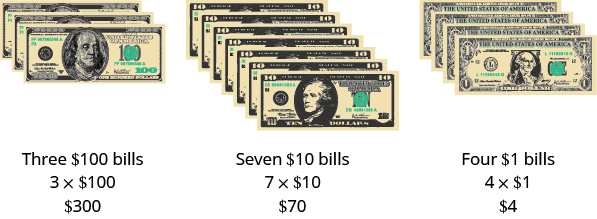
Find the total value of each kind of bill, and then add to find the total. The wallet contains ![]()

Base-10 blocks provide another way to model place value, as shown in (Figure). The blocks can be used to represent hundreds, tens, and ones. Notice that the tens rod is made up of ![]() ones, and the hundreds square is made of
ones, and the hundreds square is made of ![]() tens, or
tens, or ![]() ones.
ones.
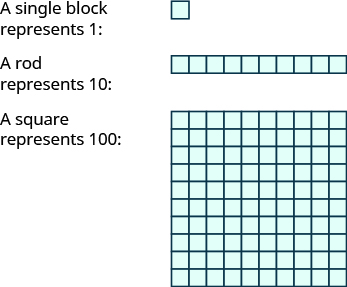
(Figure) shows the number ![]() modeled with
modeled with ![]() blocks.
blocks.
We use place value notation to show the value of the number ![]()
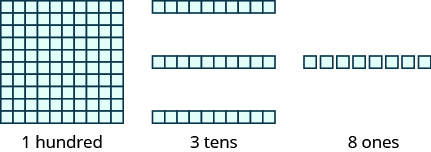

| Digit | Place value | Number | Value | Total value |
|---|---|---|---|---|
| | hundreds | | | |
| | tens | | | |
| | ones | | | |
| |
Use place value notation to find the value of the number modeled by the ![]() blocks shown.
blocks shown.

Use place value notation to find the value of the number modeled by the ![]() blocks shown.
blocks shown.
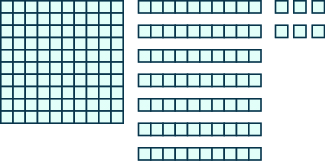
176
Use place value notation to find the value of the number modeled by the ![]() blocks shown.
blocks shown.

237
Doing the Manipulative Mathematics activity "Model Whole Numbers" will help you develop a better understanding of place value of whole numbers.
Identify the Place Value of a Digit
By looking at money and ![]() blocks, we saw that each place in a number has a different value. A place value chart is a useful way to summarize this information. The place values are separated into groups of three, called periods. The periods are ones, thousands, millions, billions, trillions, and so on. In a written number, commas separate the periods.
blocks, we saw that each place in a number has a different value. A place value chart is a useful way to summarize this information. The place values are separated into groups of three, called periods. The periods are ones, thousands, millions, billions, trillions, and so on. In a written number, commas separate the periods.
Just as with the ![]() blocks, where the value of the tens rod is ten times the value of the ones block and the value of the hundreds square is ten times the tens rod, the value of each place in the place-value chart is ten times the value of the place to the right of it.
blocks, where the value of the tens rod is ten times the value of the ones block and the value of the hundreds square is ten times the tens rod, the value of each place in the place-value chart is ten times the value of the place to the right of it.
(Figure) shows how the number ![]() is written in a place value chart.
is written in a place value chart.
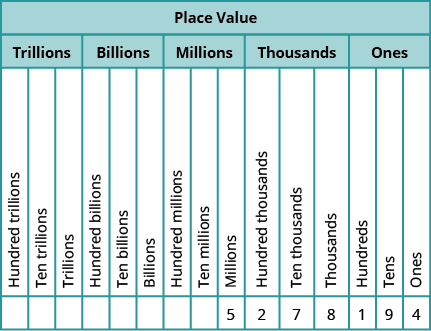
Solution
Write the number in a place value chart, starting at the right.
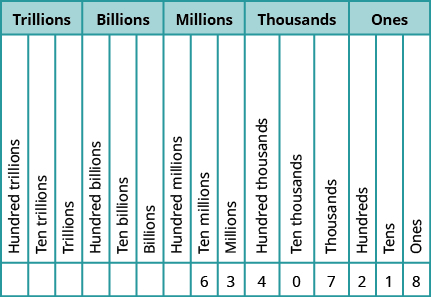
- ⓐ ten millions
- ⓑ tens
- ⓒ hundred thousands
- ⓓ millions
- ⓔ ones
- ⓐ billions
- ⓑ ten thousands
- ⓒ tens
- ⓓ hundred thousands
- ⓔ hundred millions
Use Place Value to Name Whole Numbers
When you write a check, you write out the number in words as well as in digits. To write a number in words, write the number in each period followed by the name of the period without the 's' at the end. Start with the digit at the left, which has the largest place value. The commas separate the periods, so wherever there is a comma in the number, write a comma between the words. The ones period, which has the smallest place value, is not named.

So the number ![]() is written thirty-seven million, five hundred nineteen thousand, two hundred forty-eight.
is written thirty-seven million, five hundred nineteen thousand, two hundred forty-eight.
Notice that the word and is not used when naming a whole number.
Name a whole number in words.
- Starting at the digit on the left, name the number in each period, followed by the period name. Do not include the period name for the ones.
- Use commas in the number to separate the periods.
Name the number ![]() in words.
in words.
Solution
| Begin with the leftmost digit, which is 8. It is in the trillions place. | eight trillion |
| The next period to the right is billions. | one hundred sixty-five billion |
| The next period to the right is millions. | four hundred thirty-two million |
| The next period to the right is thousands. | ninety-eight thousand |
| The rightmost period shows the ones. | seven hundred ten |

Putting all of the words together, we write ![]() as eight trillion, one hundred sixty-five billion, four hundred thirty-two million, ninety-eight thousand, seven hundred ten.
as eight trillion, one hundred sixty-five billion, four hundred thirty-two million, ninety-eight thousand, seven hundred ten.
Name each number in words: ![]()
nine trillion, two hundred fifty-eight billion, one hundred thirty-seven million, nine hundred four thousand, sixty-one
Name each number in words: ![]()
seventeen trillion, eight hundred sixty-four billion, three hundred twenty-five million, six hundred nineteen thousand, four
A student conducted research and found that the number of mobile phone users in the United States during one month in ![]() was
was ![]() Name that number in words.
Name that number in words.
Solution
Identify the periods associated with the number.

Name the number in each period, followed by the period name. Put the commas in to separate the periods.
Millions period: three hundred twenty-seven million
Thousands period: five hundred seventy-seven thousand
Ones period: five hundred twenty-nine
So the number of mobile phone users in the Unites States during the month of April was three hundred twenty-seven million, five hundred seventy-seven thousand, five hundred twenty-nine.
The population in a country is ![]() Name that number.
Name that number.
three hundred sixteen million, one hundred twenty-eight thousand, eight hundred thirty nine
One year is ![]() seconds. Name that number.
seconds. Name that number.
thirty one million, five hundred thirty-six thousand
Use Place Value to Write Whole Numbers
We will now reverse the process and write a number given in words as digits.
Use place value to write a whole number.
- Identify the words that indicate periods. (Remember the ones period is never named.)
- Draw three blanks to indicate the number of places needed in each period. Separate the periods by commas.
- Name the number in each period and place the digits in the correct place value position.
Write the following numbers using digits.
- ⓐ fifty-three million, four hundred one thousand, seven hundred forty-two
- ⓑ nine billion, two hundred forty-six million, seventy-three thousand, one hundred eighty-nine
Solution
ⓐ Identify the words that indicate periods.
Except for the first period, all other periods must have three places. Draw three blanks to indicate the number of places needed in each period. Separate the periods by commas.
Then write the digits in each period.

Put the numbers together, including the commas. The number is ![]()
ⓑ Identify the words that indicate periods.
Except for the first period, all other periods must have three places. Draw three blanks to indicate the number of places needed in each period. Separate the periods by commas.
Then write the digits in each period.

The number is ![]()
Notice that in part ⓑ, a zero was needed as a place-holder in the hundred thousands place. Be sure to write zeros as needed to make sure that each period, except possibly the first, has three places.
Write each number in standard form:
fifty-three million, eight hundred nine thousand, fifty-one.
53,809,051
Write each number in standard form:
two billion, twenty-two million, seven hundred fourteen thousand, four hundred sixty-six.
2,022,714,466
A state budget was about ![]() billion. Write the budget in standard form.
billion. Write the budget in standard form.
Solution
Identify the periods. In this case, only two digits are given and they are in the billions period. To write the entire number, write zeros for all of the other periods.

So the budget was about ![]()
Write each number in standard form:
The closest distance from Earth to Mars is about ![]() million miles.
million miles.
34,000,000 miles
Write each number in standard form:
The total weight of an aircraft carrier is ![]() million pounds.
million pounds.
204,000,000 pounds
Round Whole Numbers
In ![]() the U.S. Census Bureau reported the population of the state of New York as
the U.S. Census Bureau reported the population of the state of New York as ![]() people. It might be enough to say that the population is approximately
people. It might be enough to say that the population is approximately ![]() million. The word approximately means that
million. The word approximately means that ![]() million is not the exact population, but is close to the exact value.
million is not the exact population, but is close to the exact value.
The process of approximating a number is called rounding. Numbers are rounded to a specific place value depending on how much accuracy is needed. ![]() million was achieved by rounding to the millions place. Had we rounded to the one hundred thousands place, we would have
million was achieved by rounding to the millions place. Had we rounded to the one hundred thousands place, we would have ![]() as a result. Had we rounded to the ten thousands place, we would have
as a result. Had we rounded to the ten thousands place, we would have ![]() as a result, and so on. The place value to which we round to depends on how we need to use the number.
as a result, and so on. The place value to which we round to depends on how we need to use the number.
Using the number line can help you visualize and understand the rounding process. Look at the number line in (Figure). Suppose we want to round the number ![]() to the nearest ten. Is
to the nearest ten. Is ![]() closer to
closer to ![]() or
or ![]() on the number line?
on the number line?
Now consider the number ![]() Find
Find ![]() in (Figure).
in (Figure).
How do we round ![]() to the nearest ten. Find
to the nearest ten. Find ![]() in (Figure).
in (Figure).
The number ![]() is exactly midway between
is exactly midway between ![]() and
and ![]()

So that everyone rounds the same way in cases like this, mathematicians have agreed to round to the higher number, ![]() So,
So, ![]() rounded to the nearest ten is
rounded to the nearest ten is ![]()
Now that we have looked at this process on the number line, we can introduce a more general procedure. To round a number to a specific place, look at the number to the right of that place. If the number is less than ![]() round down. If it is greater than or equal to
round down. If it is greater than or equal to ![]() round up.
round up.
So, for example, to round ![]() to the nearest ten, we look at the digit in the ones place.
to the nearest ten, we look at the digit in the ones place.
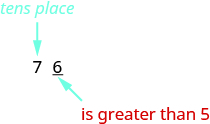
The digit in the ones place is a ![]() Because
Because ![]() is greater than or equal to
is greater than or equal to ![]() we increase the digit in the tens place by one. So the
we increase the digit in the tens place by one. So the ![]() in the tens place becomes an
in the tens place becomes an ![]() Now, replace any digits to the right of the
Now, replace any digits to the right of the ![]() with zeros. So,
with zeros. So, ![]() rounds to
rounds to ![]()
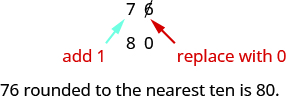
Let's look again at rounding ![]() to the nearest
to the nearest ![]() Again, we look to the ones place.
Again, we look to the ones place.
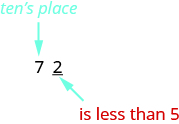
The digit in the ones place is ![]() Because
Because ![]() is less than
is less than ![]() we keep the digit in the tens place the same and replace the digits to the right of it with zero. So
we keep the digit in the tens place the same and replace the digits to the right of it with zero. So ![]() rounded to the nearest ten is
rounded to the nearest ten is ![]()

Round a whole number to a specific place value.
- Locate the given place value. All digits to the left of that place value do not change.
- Underline the digit to the right of the given place value.
- Determine if this digit is greater than or equal to

- Yes—add
 to the digit in the given place value.
to the digit in the given place value. - No—do not change the digit in the given place value.
- Yes—add
- Replace all digits to the right of the given place value with zeros.
Round ![]() to the nearest ten.
to the nearest ten.
Round to the nearest ten: ![]()
160
Round to the nearest ten: ![]()
880
Round each number to the nearest hundred:
- ⓐ

- ⓑ

Round to the nearest hundred: ![]()
17,900
Round to the nearest hundred: ![]()
5,000
Round each number to the nearest thousand:
- ⓐ

- ⓑ

Round to the nearest thousand: ![]()
64,000
Round to the nearest thousand: ![]()
156,000
Key Concepts
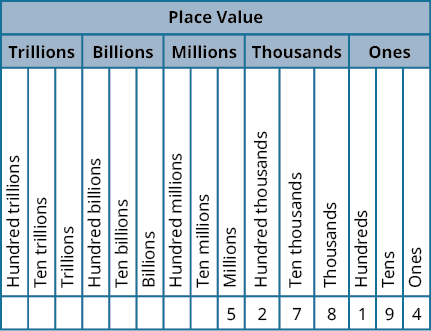
- Name a whole number in words.
- Starting at the digit on the left, name the number in each period, followed by the period name. Do not include the period name for the ones.
- Use commas in the number to separate the periods.
- Use place value to write a whole number.
- Identify the words that indicate periods. (Remember the ones period is never named.)
- Draw three blanks to indicate the number of places needed in each period.
- Name the number in each period and place the digits in the correct place value position.
- Round a whole number to a specific place value.
- Locate the given place value. All digits to the left of that place value do not change.
- Underline the digit to the right of the given place value.
- Determine if this digit is greater than or equal to 5. If yes—add 1 to the digit in the given place value. If no—do not change the digit in the given place value.
- Replace all digits to the right of the given place value with zeros.
Practice Makes Perfect
Identify Counting Numbers and Whole Numbers
In the following exercises, determine which of the following numbers are ⓐ counting numbers ⓑ whole numbers.
![]()
- ⓐ 5, 125
- ⓑ 0, 5, 125
![]()
![]()
- ⓐ 50, 221
- ⓑ 0, 50, 221
![]()
Model Whole Numbers
In the following exercises, use place value notation to find the value of the number modeled by the ![]() blocks.
blocks.
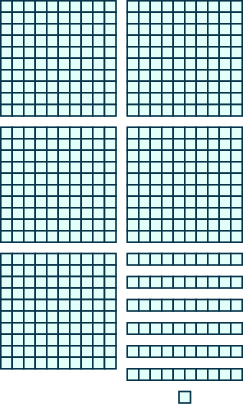
561

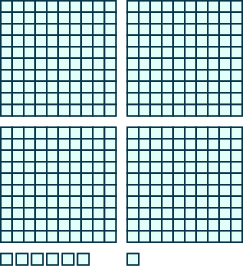
407

Identify the Place Value of a Digit
In the following exercises, find the place value of the given digits.
![]()
- ⓐ 9
- ⓑ 6
- ⓒ 0
- ⓓ 7
- ⓔ 5
- ⓐ thousands
- ⓑ hundreds
- ⓒ tens
- ⓓ ten thousands
- ⓔ hundred thousands
![]()
- ⓐ 9
- ⓑ 3
- ⓒ 2
- ⓓ 8
- ⓔ 7
![]()
- ⓐ 8
- ⓑ 6
- ⓒ 4
- ⓓ 7
- ⓔ 0
- ⓐ hundred thousands
- ⓑ millions
- ⓒ thousands
- ⓓ tens
- ⓔ ten thousands
![]()
- ⓐ 8
- ⓑ 4
- ⓒ 2
- ⓓ 6
- ⓔ 7
Use Place Value to Name Whole Numbers
In the following exercises, name each number in words.
![]()
One thousand, seventy-eight
![]()
![]()
Three hundred sixty-four thousand, five hundred ten
![]()
![]()
Five million, eight hundred forty-six thousand, one hundred three
![]()
![]()
Thirty seven million, eight hundred eighty-nine thousand, five
![]()
The height of Mount Ranier is ![]() feet.
feet.
Fourteen thousand, four hundred ten
The height of Mount Adams is ![]() feet.
feet.
Seventy years is ![]() hours.
hours.
Six hundred thirteen thousand, two hundred
One year is ![]() minutes.
minutes.
The U.S. Census estimate of the population of Miami-Dade county was ![]()
Two million, six hundred seventeen thousand, one hundred seventy-six
The population of Chicago was ![]()
There are projected to be ![]() college and university students in the US in five years.
college and university students in the US in five years.
Twenty three million, eight hundred sixty-seven thousand
About twelve years ago there were ![]() registered automobiles in California.
registered automobiles in California.
The population of China is expected to reach ![]() in
in ![]()
One billion, three hundred seventy-seven million, five hundred eighty-three thousand, one hundred fifty-six
The population of India is estimated at ![]() as of July
as of July ![]()
Use Place Value to Write Whole Numbers
In the following exercises, write each number as a whole number using digits.
thirty-five thousand, nine hundred seventy-five
35,975
sixty-one thousand, four hundred fifteen
eleven million, forty-four thousand, one hundred sixty-seven
11,044,167
eighteen million, one hundred two thousand, seven hundred eighty-three
three billion, two hundred twenty-six million, five hundred twelve thousand, seventeen
3,226,512,017
eleven billion, four hundred seventy-one million, thirty-six thousand, one hundred six
The population of the world was estimated to be seven billion, one hundred seventy-three million people.
7,173,000,000
The age of the solar system is estimated to be four billion, five hundred sixty-eight million years.
Lake Tahoe has a capacity of thirty-nine trillion gallons of water.
39,000,000,000,000
The federal government budget was three trillion, five hundred billion dollars.
Round Whole Numbers
In the following exercises, round to the indicated place value.
Round to the nearest ten:
- ⓐ

- ⓑ

- ⓐ 390
- ⓑ 2,930
Round to the nearest ten:
- ⓐ

- ⓑ

Round to the nearest hundred:
- ⓐ

- ⓑ

- ⓐ 13,700
- ⓑ 391,800
Round to the nearest hundred:
- ⓐ

- ⓑ

Round to the nearest ten:
- ⓐ

- ⓑ

- ⓐ 1,490
- ⓑ 1,500
Round to the nearest thousand:
- ⓐ

- ⓑ

Round to the nearest hundred:
- ⓐ

- ⓑ

Round to the nearest thousand:
- ⓐ

- ⓑ

Everyday Math
Writing a Check Jorge bought a car for ![]() He paid for the car with a check. Write the purchase price in words.
He paid for the car with a check. Write the purchase price in words.
Twenty four thousand, four hundred ninety-three dollars
Writing a Check Marissa's kitchen remodeling cost ![]() She wrote a check to the contractor. Write the amount paid in words.
She wrote a check to the contractor. Write the amount paid in words.
Buying a Car Jorge bought a car for ![]() Round the price to the nearest:
Round the price to the nearest:
- ⓐ ten dollars
- ⓑ hundred dollars
- ⓒ thousand dollars
- ⓓ ten-thousand dollars
- ⓐ ?24,490
- ⓑ ?24,500
- ⓒ ?24,000
- ⓓ ?20,000
Remodeling a Kitchen Marissa's kitchen remodeling cost ![]() Round the cost to the nearest:
Round the cost to the nearest:
- ⓐ ten dollars
- ⓑ hundred dollars
- ⓒ thousand dollars
- ⓓ ten-thousand dollars
Population The population of China was ![]() in
in ![]() Round the population to the nearest:
Round the population to the nearest:
- ⓐ billion people
- ⓑ hundred-million people
- ⓒ million people
Astronomy The average distance between Earth and the sun is ![]() kilometers. Round the distance to the nearest:
kilometers. Round the distance to the nearest:
- ⓐ hundred-million kilometers
- ⓑ ten-million kilometers
- ⓒ million kilometers
Writing Exercises
In your own words, explain the difference between the counting numbers and the whole numbers.
Answers may vary. The whole numbers are the counting numbers with the inclusion of zero.
Give an example from your everyday life where it helps to round numbers.
Self Check
ⓐ After completing the exercises, use this checklist to evaluate your mastery of the objectives of this section.
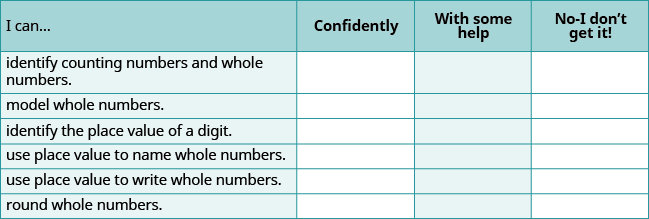
ⓑ If most of your checks were…
…confidently. Congratulations! You have achieved the objectives in this section. Reflect on the study skills you used so that you can continue to use them. What did you do to become confident of your ability to do these things? Be specific.
…with some help. This must be addressed quickly because topics you do not master become potholes in your road to success. In math, every topic builds upon previous work. It is important to make sure you have a strong foundation before you move on. Who can you ask for help? Your fellow classmates and instructor are good resources. Is there a place on campus where math tutors are available? Can your study skills be improved?
…no—I don't get it! This is a warning sign and you must not ignore it. You should get help right away or you will quickly be overwhelmed. See your instructor as soon as you can to discuss your situation. Together you can come up with a plan to get you the help you need.
Glossary
- coordinate
- A number paired with a point on a number line is called the coordinate of the point.
- counting numbers
- The counting numbers are the numbers 1, 2, 3, ….
- number line
- A number line is used to visualize numbers. The numbers on the number line get larger as they go from left to right, and smaller as they go from right to left.
- origin
- The origin is the point labeled 0 on a number line.
- place value system
- Our number system is called a place value system because the value of a digit depends on its position, or place, in a number.
- rounding
- The process of approximating a number is called rounding.
- whole numbers
- The whole numbers are the numbers 0, 1, 2, 3, ….
What Is the Next Whole Number After One Hundred Thousand
Source: https://opentextbc.ca/prealgebraopenstax/chapter/introduction-to-whole-numbers/
0 Response to "What Is the Next Whole Number After One Hundred Thousand"
Post a Comment